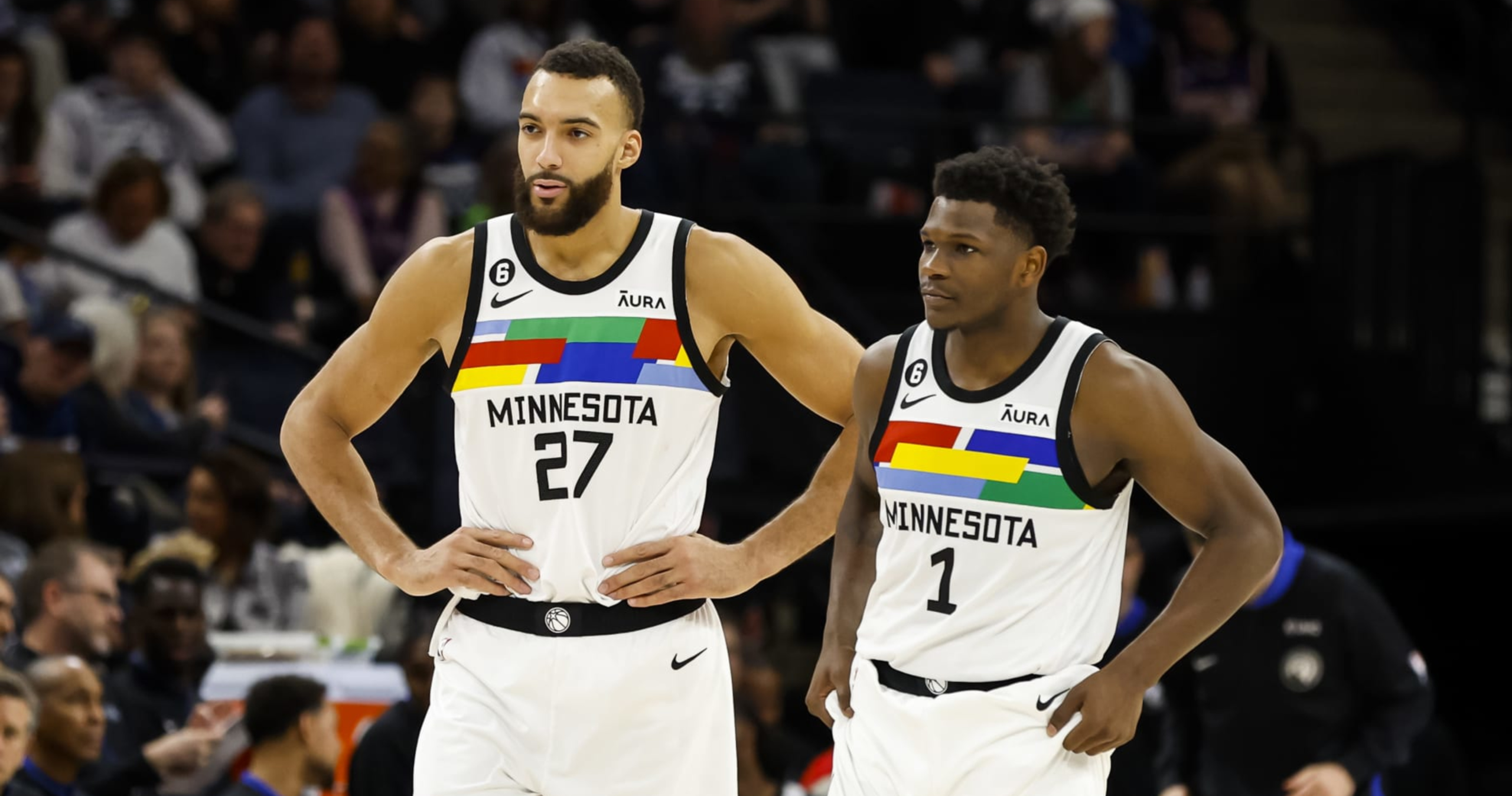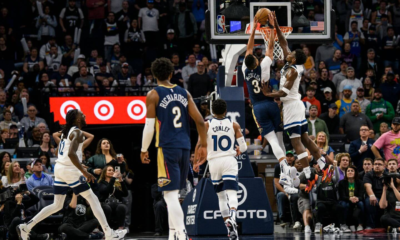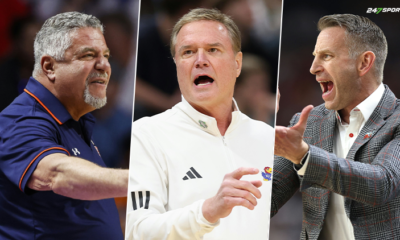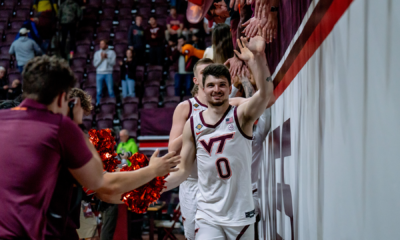Sports
Biggest Risers and Fallers from B/R NBA Top 100 – Bleacher Report

As is annual summer tradition all over the internet, Bleacher Report released its preseason NBA Top 100 player rankings this week.
And as you might imagine, after an eventful 2022-23 campaign, plenty of offseason player movement and the opening games of the FIBA World Cup, this year’s top 100 looks quite a bit different than last summer’s.
As you continue to pore over, argue and maybe even virtually scream about that list, we’re here to break down the biggest risers, fallers and newcomers for 2023-24.
For the methodology that gave us this year’s list, feel free to reference back to that slideshow itself. Below, you’ll find the five highest-ranked players who didn’t make the top 100 last summer, the five players who climbed the most from last year’s rank and the five who fell the most.
It should come as little surprise that Austin Reaves didn’t make the cut in 2022.
His rookie campaign was intriguing, but 7.3 points and 1.8 assists with barely above-average scoring efficiency couldn’t have prepared anyone for the leap with which Reaves closed out his second campaign.
Reaves is now, quite comfortably, the third-best player on a Los Angeles Lakers team that just made the Western Conference Finals.
Over his last 34 regular-season and postseason games, he averaged 17.8 points (on just 10.9 field-goal attempts) and 5.2 assists. In the playoffs, LeBron James was comfortable deferring to his playmaking down the stretch of close games. And now, he’s an early standout for Team USA’s World Cup team.
At this point, his No. 69 ranking is almost starting to feel a little conservative.
Derrick White had a 2021-22 campaign that probably warranted more attention.
He finished that season in the 92nd percentile in Dunks and Threes’ estimated plus-minus (EPM is one of the most trusted catch-all metrics in NBA front offices). He was already emerging as one of the game’s better perimeter defenders. And his playmaking was opening up more opportunities for Jayson Tatum, Jaylen Brown and the rest of the Boston Celtics.
But a tough 2022 postseason in which he shot 36.4 percent from the floor and 31.3 percent from deep may have thrown us off the scent.
There was no such closing kick in 2022-23, when White was good enough to convince Boston it could finally move on from the Marcus Smart era.
Heading into next season, White will be the undisputed starting 1 for the title-contending Celtics. And though his basic numbers (12.4 points and 3.9 assists in 2022-23) may not leap off the screen, his unselfishness, headiness and defense certainly do.
As was the case with White, Cameron Johnson’s arrival in the top 100 might represent something of a delayed reaction.
He already looked like one of the game’s better three-and-D forwards after a 2021-22 in which he averaged 12.5 points and shot 42.5 percent from deep, and he proved that was far from a fluke in 2022-23.
Johnson backed up that season with a career-high 15.5 points in 2022-23. He shot 40.4 percent from deep. And with his 6’8″ frame and 6’10” wingspan, he continues to be a versatile, switchable defender who can clog up passing lanes and do a decent job of staying in front of slashers.
This may feel a little ambitious.
It’s certainly going to take Victor Wembanyama some time to adjust to the size, speed and physicality of the NBA. And a 27.5 three-point percentage in 2022-23 suggests his shot may be on a longer learning curve than anticipated.
Oh, and he’s still 19 years old until January.
Considering all of the above, pegging him as a borderline top-60 player right out of the gate is, well…OK, yeah. It’s ambitious.
But we’ve also never seen a 7’4″ player move the way Wemby does. The fluidity of his jump shot quickly puts any concerns over that three-point percentage to rest (his 82.8 free-throw percentage helps too). His ball-handling is without precedent for someone his size. And his length and defensive instincts could make him a plus on that end right away.
And no, the French league in which Wembanyama played isn’t the NBA. Nor is it the best league outside the NBA. But he was playing against grown men last season. Professionals. And 21.6 points, 10.4 rebounds, 3.0 blocks and an MVP award from that league is nothing to sneeze at.
We move from fairly ambitious to fairly conservative with Lauri Markkanen, who went from outside the top 100 in 2022 to All-Star starter and bona fide All-NBA candidate during the 2022-23 season.
After averaging 25.6 points and 8.6 rebounds while shooting 39.1 percent from three and finishing 13th in estimated wins (the cumulative version of estimated plus-minus), it wouldn’t have been hard to justify having Markkanen several spots higher.
Of course, then you look at the list and remember how much talent is packed in the NBA right now. Making the top 30 has never felt tougher.
Coming off a solid rookie campaign in 2021-22, we forecast a pretty comfy spot in the top 100 for Franz Wagner in Year 2, but ranking him 81st proved conservative.
Wagner averaged 18.6 points and 3.5 assists for a plucky Orlando Magic squad that was above .500 over its last 57 games, and he finished in the 92nd percentile in EPM.
His combination of size (6’9″ with a 6’11” wingspan) and perimeter skills make him one of the game’s more intriguing forwards. And at 22 years old, it’s safe to assume this rise isn’t over.
Through little to no fault of his own, Tobias Harris saw all of his marks for points, rebounds and assists per game dip pretty comfortably from 2021-22 to 2022-23.
That actually led to a noticeable bump up in efficiency (his true shooting percentage and EPM both rose), but the decline in raw production suggests we may be nearing the end of Harris’ prime.
He’s 31 years old, and his scoring average has declined in each of the last four campaigns, ending at 14.7 points in 2022-23.
The Tyrese Haliburton-Domantas Sabonis trade, at least for now, is looking like a classic win-win. And that description has as much to do with De’Aaron Fox as it does either Haliburton or Sabonis.
During Haliburton’s first full season with the Indiana Pacers, Fox averaged 25.0 points and 6.1 assists with an above-average true shooting percentage. He was All-NBA and won the league’s first Clutch Player of the Year award.
And his increase in overall impact from 2021-22 probably could’ve had him in the running for Most Improved Player too.
That season, his plus-0.2 EPM ranked in the 71st percentile. In 2022-23, he posted a 2.8 EPM that ranked in the 91st percentile.
You’ll notice that Barrett fell the same number of spots as Harris. The tiebreaker here is that he fell from the slightly higher perch. For risers, the tiebreaker will be who rose from the lower perch.
So, with that out of the way, let’s dig into why Barrett is really here.
After a second season in which he averaged 17.6 points and shot 40.1 percent from deep in 2020-21, it felt safe to assume that he would develop into, at the very least, a serviceable wing.
But his inefficiency as a scorer over the last two seasons has been crippling for both him and the New York Knicks.
Over the last two seasons, Barrett’s 1.2 points per field-goal attempt is comfortably below the league average of 1.28. And if you multiply the difference between those two numbers by Barrett’s field-goal attempts, you find that he’s scored 194 fewer points than a perfectly average-efficiency scorer would have with his number of shots.
Among the 686 players who’ve scored at least one point over that stretch, Barrett’s minus-194.0 points added ranks 670th.
And in the same two years, New York is minus-1.7 points per 100 possessions when Barrett plays and plus-7.3 when he doesn’t.
It’s hard for a team to survive that many misses.
Mikal Bridges’ rank probably would’ve risen without the Kevin Durant trade, but his brief stint with the Brooklyn Nets absolutely ensured a jump.
After averaging 14.2 points in 2021-22 and 17.2 in 56 games with the Phoenix Suns in 2022-23, Bridges exploded as a No. 1 option in Brooklyn. In his 27 games there, he put up 26.1 points and 2.5 threes while shooting 37.6 percent from deep.
After two or three years establishing himself as a bona fide three-and-D specialist, Bridges proved he can be more than that last season.
It may have had something to do with a gruesome-looking injury to the ring finger on his shooting hand, but John Collins’ production and efficiency both tumbled in 2022-23.
His 13.1 points per game was his lowest average since his rookie season, and his 29.2 three-point percentage was a career low.
And with the outside shot abandoning him, his lack of high-end defensive impact became a bit more glaring too.
As Josh Giddey leads the Australian national team with 19.0 points, 7.3 assists and 5.0 rebounds per game during the FIBA World Cup, it’s hard to believe he’s still just 20 years old.
And the fact that his NBA marks for points per game, rebounds per game, assists per game, field-goal percentage and three-point percentage all went up from 2021-22 to 2022-23 suggests his performance on the international stage isn’t a fluke.
Giddey is an underrated rebounder (he’s led the Oklahoma City Thunder in rebounds per game in each of his two NBA seasons) and ahead-of-his-age playmaker who’s on a star trajectory.
He just needs to find some consistency with his jumper.
Father Time is, as they say, undefeated. And he finally seems to have found 38-year-old point guard Chris Paul.
Advanced stats still said he performed like a top-50 player in 2022-23, but injuries limited him to just 59 regular-season games and knocked him out of another playoff run.
And now that he’s joining a Golden State Warriors team that may have the best point guard of all time still clinging to his prime, it’s safe to assume CP3’s role and minutes could be more limited than they’ve ever been before.
After he averaged 13.9 points and 8.9 assists last season, it wouldn’t be surprising to see both marks dip a bit further in Golden State.
Like Reaves and Giddey, Paolo Banchero appears to be using the FIBA World Cup as some kind of springboard after a solid 2022-23 campaign.
After securing NBA Rookie of the Year as a wing with 20.0 points and 3.7 assists (on a way-below-average true shooting percentage), the 6’10” Banchero has embraced his role as a small-ball 5 with Team USA and is punishing defenders inside and flashing some decent rim-protection instincts.
Of course, this isn’t to suggest he should be a dedicated center in the NBA, but he’s showing off some impressive versatility this summer and could be in the mix for All-Star consideration as early as this season.
There were a few things working against Rudy Gobert last season (and clearly, during the process of compiling this top 100).
First, he’s now 31 years old. And while his defensive EPM still ranked in the 92nd percentile during his first season with the Minnesota Timberwolves, a slight step back in explosiveness took him from “absolute wrecking ball against most offenses” to something closer to “excellent deterrent around the paint.”
Karl-Anthony Towns was limited to just 29 games due to injury, but being a part of jumbo lineups didn’t really serve Gobert well either.
KAT’s a great floor-spacer, but he still benefits from occasional touches inside. And there’s really nowhere for Gobert to go when that happens. No one will follow him out to the three-point line, and hanging out in the dunker’s spot just makes everything too crowded.
With the Utah Jazz, Gobert typically played in lineups that were almost perfectly tuned to fit his strengths. Now, in combination with aging out of his prime, his weaknesses are getting more of a spotlight.
Russell Westbrook (87 to Out)
After ranking 30th in 2020-21, 33rd in 2021-22 and 87th last summer, Russell Westbrook has finally fallen out of the top 100 altogether.
And while he deserves a ton of credit for keeping the Los Angeles Clippers competitive after Paul George and Kawhi Leonard went down, it’s hard to argue against his drop.
He hasn’t had an above-average true shooting percentage since 2016-17. And he really hasn’t been even close.
Jayson Tatum (7 to 5)
On the other end of the spectrum, 25-year-old Jayson Tatum is in the top five for the first time in his career.
He finished first in the league in defensive win shares in 2021-22 and then followed that up with a third-place finish in 2022-23. Add that to his career-high 30.1 points this season, and it’s easy to see why he’s the top-ranked wing.
Shai Gilgeous-Alexander (33 to 11)
At No. 11, Shai Gilgeous-Alexander is knocking at the door of the top 10 after being ranked 33rd last year. And that leap from All-Star contender to All-NBA contender (and maybe even higher, in SGA’s case) might be even tougher than the rises of players like Giddey or Banchero.
The top 30 to 40 in the NBA is as talent-rich as it’s ever been, and pushing through that is impressive.
Gilgeous-Alexander’s first-team All-NBA campaign in 2022-23 was undeniable, though. He averaged 31.4 points, 5.5 assists, 1.6 steals and 1.0 blocks, and Michael Jordan is the only other player in NBA history to match or exceed all four marks in a single season (MJ did it twice).
Anthony Edwards (26 to 15)
The jump wasn’t quite as big as SGA’s, but Anthony Edwards traveled between the same general areas (All-Star contender to All-NBA contender).
And his rise came on the heels of another eye-opening playoff performance. In 11 career postseason games, Edwards is now averaging 28.1 points, 4.0 assists, 1.5 steals and 1.5 blocks.
Jordan is the only player in league history to match or exceed Ant’s totals in those four categories in his first 11 playoff games.
Aaron Gordon (93 to 65)
Aaron Gordon’s willingness to accept a different role than what he might’ve imagined for himself when he was the fourth overall pick in 2014 was a huge part of the Nuggets’ championship run.
With the Magic, Gordon often tried to operate as a ball-handling wing who put up plenty of jump shots. With Denver, particularly in 2022-23, he became one of the game’s most dynamic rim runners and finishers while devoting plenty of energy to the defensive end.
Jamal Murray (37 to 16)
As @carbicc astutely pointed out on the platform formerly known as Twitter, “Jamal Murray is the only player in NBA history who people are telling him to prove it in the regular season.”
Well, not us writers here at Bleacher Report.
After an absurd playoff run in which he averaged 26.1 points, 7.1 assists and 1.5 steals on the way to a championship, it’s clear that Murray is a top-20 to -25 talent, even if he doesn’t always have his foot on the gas before the playoffs.
Beyond the players above, this year’s top 100 gave us a bunch of moves that at least deserve a mention in passing.
Kristaps Porziņģis, Jaren Jackson Jr. and Jalen Brunson all climbed at least 20 spots, while Jordan Poole, Khris Middleton and CJ McCollum all fell at least 20 spots.
Trae Young’s drop from 12 to 30 probably came as something of a surprise too. He’s one of the game’s best offensive engines, but he may suddenly be facing a prove-it season (despite already making an Eastern Conference Finals).
Finally, some notable newcomers who could be mainstays on the list for the next few years include Jaden McDaniels, Keegan Murray, Jalen Williams and Alperen Şengün.
Paolo Banchero (78 to 40)
Josh Giddey (91 to 57)
Mikal Bridges (58 to 25)
De’Aaron Fox (47 to 17)
Franz Wagner (81 to 52)
Aaron Gordon (93 to 65)
Jalen Brunson (61 to 36)
Jaren Jackson Jr. (54 to 31)
Shai Gilgeous-Alexander (33 to 11)
Kristaps Porziņģis (64 to 43)
Jamal Murray (37 to 16)
Julius Randle (73 to 55)
Tyrese Haliburton (51 to 33)
O.G. Anunoby (63 to 46)
Domantas Sabonis (50 to 35)
Myles Turner (71 to 57)
Kyle Kuzma (90 to 77)
Keldon Johnson (89 to 78)
Anthony Edwards (26 to 15)
Jerami Grant (65 to 56)
Cade Cunningham (48 to 39)
Andrew Wiggins (53 to 45)
Anthony Davis (17 to 10)
Tyrese Maxey (57 to 51)
Pascal Siakam (28 to 24)
Devin Booker (13 to 9)
Bam Adebayo (30 to 27)
Anfernee Simons (76 to 74)
Jayson Tatum (7 to 5)
Joel Embiid (6 to 4)
Donovan Mitchell (21 to 20)
LeBron James (8 to 7)
Nikola Jokić (2 to 1)
Rudy Gobert (20 to 62)
Chris Paul (31 to 69)
John Collins (60 to 93)
Tobias Harris (68 to 100)
RJ Barrett (59 to 91)
CJ McCollum (44 to 75)
Khris Middleton (29 to 50)
Jordan Poole (56 to 76)
Marcus Smart (52 to 71)
Jarrett Allen (45 to 64)
Fred VanVleet (41 to 59)
Trae Young (12 to 30)
Klay Thompson (43 to 60)
Zach LaVine (27 to 44)
LaMelo Ball (32 to 48)
Malcolm Brogdon (74 to 89)
Nikola Vučević (66 to 81)
Deandre Ayton (40 to 54)
Scottie Barnes (41 to 53)
Dejounte Murray (36 to 47)
Ja Morant (10 to 21)
Jalen Green (70 to 80)
Bradley Beal (25 to 34)
DeMar DeRozan (34 to 42)
Karl-Anthony Towns (16 to 23)
Desmond Bane (55 to 61)
Zion Williamson (22 to 28)
Brandon Ingram (24 to 29)
Michael Porter Jr. (67 to 71)
Tyler Herro (62 to 66)
Draymond Green (45 to 49)
James Harden (18 to 22)
Kawhi Leonard (9 to 13)
Paul George (15 to 18)
Kevin Durant (5 to 8)
Evan Mobley (39 to 41)
Jrue Holiday (35 to 37)
Kyrie Irving (23 to 25)
Stephen Curry (4 to 6)
Jimmy Butler (11 to 12)
Giannis Antetokounmpo (1 to 2)
Lauri Markkanen (32)
Victor Wembanyama (63)
Cameron Johnson (67)
Derrick White (68)
Austin Reaves (69)
Chet Holmgren (73)
Brook Lopez (79)
Alperen Şengün (82)
Scoot Henderson (83)
Jabari Smith Jr. (84)
Jalen Williams (85)
Walker Kessler (86)
Robert Williams (87)
Bruce Brown (88)
Devin Vassell (90)
Keegan Murray (92)
Bennedict Mathurin (94)
Bojan Bogdanović (94)
Nic Claxton (96)
Jaden McDaniels (97)
Kevon Looney (98)
Josh Hart (99)
*”Newcomer” is defined as a player who was not on the list ahead of the 2022-23 season.








